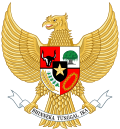First Hatta Cabinet Kabinet Hatta I | |
|---|---|
| 7th Cabinet of Indonesia | |
| 1948–1949 | |
 | |
| Date formed | 29 January 1948 |
| Date dissolved |
|
| People and organisations | |
| Head of state | Sukarno |
| Head of government | Mohammad Hatta |
| No. of ministers | 16 ministers |
| Member party | Masyumi PNI Parkindo PSI Independent |
| Opposition party | People's Democratic Front: PSI PKI PBI |
| Opposition leader | Musso Amir Sjarifoeddin |
| History | |
| Predecessor | Amir Sjarifuddin II Cabinet |
| Successor | |
| ||
|---|---|---|
Pre-independence Domestic policy Foreign policy Family Media and legacy | ||

The First Hatta Cabinet (Indonesian : Kabinet Hatta I) was Indonesia's seventh cabinet. It was formed by Vice President Mohammad Hatta, who was instructed to do so by President Sukarno on 23 January 1948, the same day the previous cabinet was declared dissolved. Following the second Dutch military aggression, when the republican capital of Yogyakarta was seized and most of the cabinet arrested, much of the cabinet was captured and sent into exile, although it was not formally disbanded. After the political leadership returned effective 13 July 1949 the cabinet continued its mandate until it was reshuffled on 4 August.


